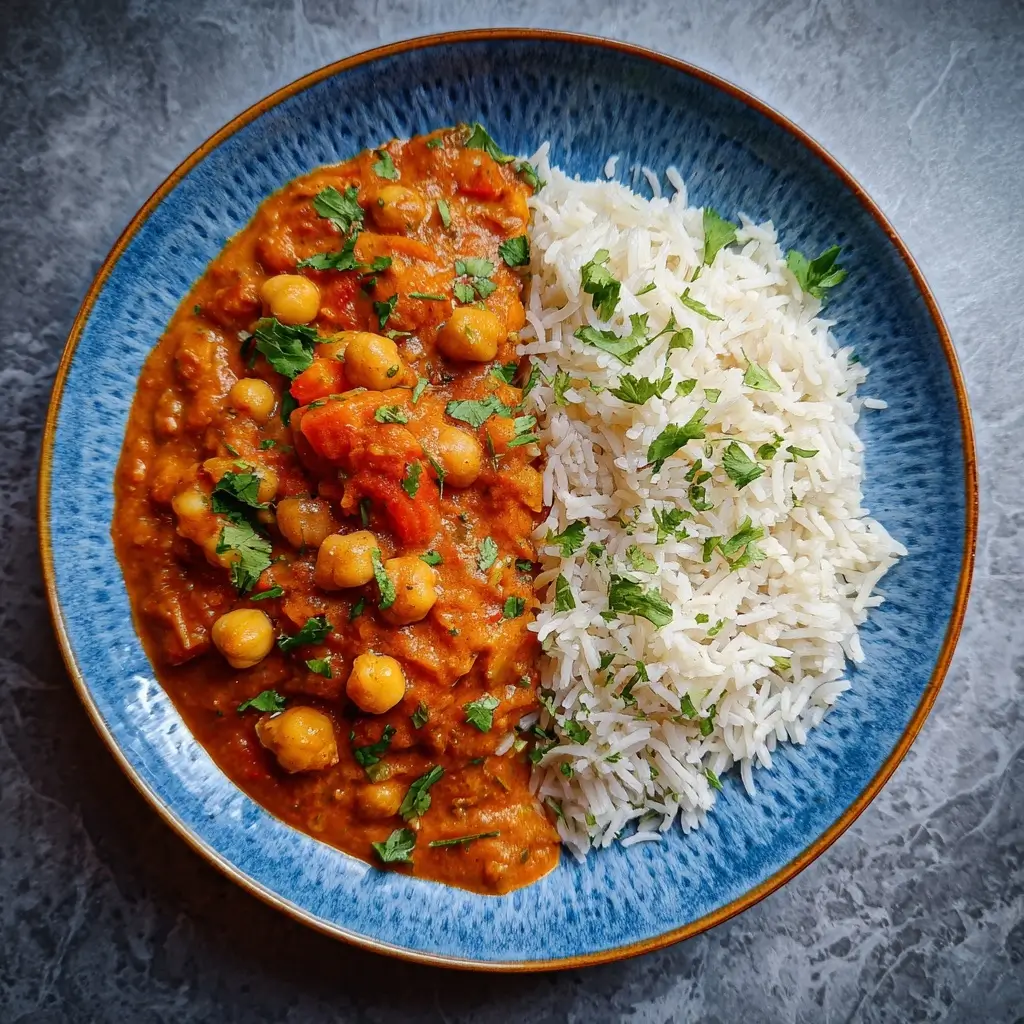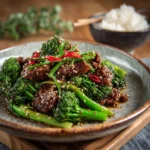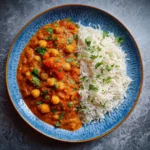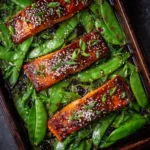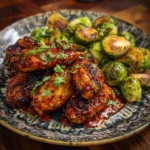Introduction
Vegan Chickpea Tikka Masala with Basmati Rice is a vibrant, aromatic, and deeply satisfying plant-based rendition of the beloved Indian classic. Traditionally made with marinated chicken simmered in a rich, creamy tomato-based sauce, this vegan adaptation swaps out animal products for protein-packed chickpeas while preserving all the bold spices and luxurious textures that make the dish so irresistible. Whether you’re a committed vegan, exploring plant-based eating, or simply craving a wholesome, flavorful meal, this recipe delivers on every front—taste, nutrition, and comfort.
The History
Tikka Masala is one of the most iconic dishes associated with Indian cuisine, though its origins are somewhat debated and shrouded in culinary legend. Many believe it was created by South Asian chefs in the UK during the mid-20th century as a way to adapt traditional Indian flavors to British palates. The dish likely evolved from tandoori cooking techniques, where meats were marinated in yogurt and spices before being grilled. When served in a creamy, mildly spiced tomato gravy, it became an instant favorite. Over time, variations spread globally, and today, Vegan Chickpea Tikka Masala honors this fusion legacy by offering a compassionate, dairy-free version without sacrificing authenticity. By using chickpeas—a staple in Indian kitchens for centuries—this recipe connects modern plant-based diets with centuries-old culinary traditions.
Ingredients Breakdown
The magic of Vegan Chickpea Tikka Masala lies in its layered flavor profile, achieved through a thoughtful combination of spices, vegetables, legumes, and aromatics. Here’s a detailed look at the key components:
- Chickpeas: The star protein source, canned or cooked from dried, providing a hearty texture and mild nutty flavor that absorbs spices beautifully.
- Basmati Rice: A long-grain aromatic rice known for its floral scent and fluffy, non-sticky texture when cooked—perfect for soaking up the luscious sauce.
- Onion, Garlic & Ginger: The holy trinity of Indian cooking, forming the foundational flavor base with their savory, pungent depth.
- Tomatoes: Use crushed tomatoes or tomato puree for a smooth, tangy backbone. Fresh tomatoes can also be blended for a fresher twist.
- Coconut Milk: Full-fat coconut milk replaces heavy cream, lending richness, creaminess, and a subtle sweetness that balances the heat.
- Spices: A blend including cumin, coriander, turmeric, smoked paprika, garam masala, and chili powder creates warmth, earthiness, and complexity.
- Lemon Juice: Adds brightness and acidity to cut through the richness.
- Fresh Cilantro: For garnish, adding a fresh, citrusy finish.
- Oil: Neutral oil like avocado or refined coconut oil ensures even cooking without overpowering flavors.
Optional additions include bell peppers, spinach, or peas for added color and nutrition.
Step-by-Step Recipe
- Cook the Basmati Rice: Rinse 1 cup of basmati rice under cold water until the water runs clear. In a medium pot, combine the rice with 2 cups of water and a pinch of salt. Bring to a boil, then reduce to a simmer, cover, and cook for 15–18 minutes until tender and fluffy. Remove from heat and let it steam, covered, for 10 minutes. Fluff with a fork before serving.
- Prepare the Chickpeas: Drain and rinse two 15-ounce cans of chickpeas. Pat them dry with a clean towel (optional step for firmer texture). Set aside.
- Sauté Aromatics: Heat 2 tablespoons of oil in a large deep skillet or Dutch oven over medium heat. Add 1 finely chopped onion and sauté for 5–7 minutes until golden brown. Stir in 4 minced garlic cloves and 1 tablespoon of freshly grated ginger, cooking for another minute until fragrant.
- Bloom the Spices: Add 1 teaspoon ground cumin, 1 teaspoon coriander, 1 teaspoon smoked paprika, ½ teaspoon turmeric, ½ teaspoon chili powder (adjust to taste), and 1 teaspoon garam masala. Stir constantly for 30–60 seconds to toast the spices, releasing their essential oils and enhancing flavor.
- Add Tomatoes: Pour in 1 can (14 oz) of crushed tomatoes. Stir well, breaking up any large chunks. Simmer for 8–10 minutes, allowing the sauce to thicken and deepen in color.
- Incorporate Chickpeas: Add the drained chickpeas to the tomato mixture. Stir to coat evenly and cook for 5 minutes, allowing them to absorb some of the flavors.
- Add Coconut Milk: Pour in 1 can (13.5 oz) of full-fat coconut milk. Stir gently to combine. Reduce heat to low and let the curry simmer uncovered for 15–20 minutes, stirring occasionally. This allows the sauce to thicken and the flavors to meld together.
- Season and Finish: Taste and adjust seasoning with salt and pepper. Squeeze in juice from half a lemon for brightness. Stir in a handful of chopped fresh cilantro just before serving.
- Serve: Spoon the hot chickpea tikka masala over a bed of fluffy basmati rice. Garnish with extra cilantro and a drizzle of coconut milk if desired.
Tips
- Rinse Rice Thoroughly: Rinsing removes excess starch, preventing clumping and ensuring light, separate grains.
- Toasting Spices is Key: Don’t skip blooming the spices in oil—it unlocks deeper, more complex flavors.
- Simmer Slowly: A longer, gentle simmer improves texture and intensifies taste. Avoid boiling vigorously, which may cause coconut milk to separate.
- Use Full-Fat Coconut Milk: Light versions may result in a watery sauce. Shake the can well before opening, or stir thoroughly if separated.
- Brown the Onions Well: Deep caramelization adds natural sweetness and richness to the sauce.
- Make Ahead Friendly: This dish tastes even better the next day as flavors continue to develop. Reheat gently on the stove.
- Freeze for Later: Store cooled curry in airtight containers for up to 3 months. Thaw overnight and reheat with a splash of water or coconut milk.
Variations and Customizations
This recipe is highly adaptable to personal preferences and dietary needs:
- Vegetable-Packed Version: Add diced bell peppers, zucchini, carrots, or spinach during the last 10 minutes of cooking.
- Protein Swaps: Replace chickpeas with lentils, tofu cubes, tempeh, or store-bought vegan chicken pieces.
- Spice Level: Control heat with chili powder or add fresh green chilies for extra kick. For milder flavor, omit chili entirely or use sweet paprika instead.
- Creamier Texture: Blend half the sauce before adding chickpeas for a silkier consistency.
- Nut-Free Option: Already naturally nut-free, making it ideal for allergy-conscious households.
- Oil-Free Version: Sauté onions and spices in vegetable broth or water to keep it completely oil-free.
- Grain Alternatives: Serve over quinoa, cauliflower rice, millet, or naan bread instead of basmati.
Health Considerations and Nutritional Value
Vegan Chickpea Tikka Masala isn’t just delicious—it’s also packed with nutrients that support overall health:
- High in Plant-Based Protein: Chickpeas provide approximately 15 grams of protein per cup, supporting muscle repair and satiety.
- Fiber-Rich: With around 12 grams of fiber per serving, this dish promotes digestive health and helps regulate blood sugar levels.
- Healthy Fats: Coconut milk contains medium-chain triglycerides (MCTs), which are metabolized differently than other fats and may support energy and brain function.
- Anti-Inflammatory Spices: Turmeric contains curcumin, a potent anti-inflammatory compound. Pairing it with black pepper (often in garam masala) enhances absorption.
- Low in Saturated Fat: Compared to traditional versions made with cream and butter, this vegan alternative is significantly lower in unhealthy fats.
- Gluten-Free: Naturally gluten-free when using certified ingredients, suitable for those with celiac disease or sensitivity.
- Vitamins & Minerals: Rich in iron, folate, manganese, and vitamin B6 from chickpeas and spices.
Portion control is advised for those monitoring calorie or fat intake due to coconut milk content, but moderate consumption fits well within balanced diets.
Ingredients
For the Chickpea Tikka Masala:
- 2 tablespoons neutral oil (avocado, sunflower, or refined coconut)
- 1 large yellow onion, finely chopped
- 4 garlic cloves, minced
- 1 tablespoon fresh ginger, grated
- 1 teaspoon ground cumin
- 1 teaspoon ground coriander
- 1 teaspoon smoked paprika
- ½ teaspoon ground turmeric
- ½ teaspoon chili powder (or to taste)
- 1 teaspoon garam masala
- 1 (14 oz) can crushed tomatoes
- 2 (15 oz) cans chickpeas, drained and rinsed
- 1 (13.5 oz) can full-fat coconut milk
- 1½ teaspoons sea salt (or to taste)
- Freshly ground black pepper, to taste
- Juice of ½ lemon
- ½ cup fresh cilantro, chopped (plus extra for garnish)
For the Basmati Rice:
- 1 cup basmati rice
- 2 cups water
- Pinch of salt
Directions
- In a small pot, rinse basmati rice under cold water until water runs clear. Add rice, water, and salt. Bring to a boil, then reduce heat to low, cover, and simmer for 15–18 minutes. Remove from heat and let stand, covered, for 10 minutes. Fluff with a fork and set aside.
- Heat oil in a large skillet or Dutch oven over medium heat. Add chopped onion and cook for 6–8 minutes, stirring occasionally, until soft and golden.
- Add garlic and ginger; cook for 1 minute until fragrant.
- Stir in cumin, coriander, smoked paprika, turmeric, chili powder, and garam masala. Toast for 30–60 seconds, stirring constantly.
- Pour in crushed tomatoes. Simmer for 8–10 minutes, stirring occasionally, until sauce reduces slightly and darkens in color.
- Add chickpeas and stir to coat. Cook for 5 minutes, allowing them to absorb flavors.
- Slowly pour in coconut milk, stirring gently to combine. Bring to a gentle simmer (do not boil rapidly).
- Cover and cook on low heat for 15–20 minutes, stirring occasionally, until sauce thickens and flavors meld.
- Season with salt, pepper, lemon juice, and chopped cilantro. Stir well.
- Serve hot over basmati rice. Garnish with additional cilantro and a swirl of coconut milk if desired.
FAQ
Can I make this in a slow cooker?
Yes! Sauté onions, garlic, ginger, and spices first, then transfer to a slow cooker. Add tomatoes, chickpeas, and coconut milk. Cook on low for 6–8 hours or high for 3–4 hours. Stir in lemon juice and cilantro before serving.
Is this dish gluten-free?
Yes, provided all ingredients used are certified gluten-free. Check labels on canned goods and spices to ensure no cross-contamination.
How do I prevent coconut milk from separating?
Avoid boiling the sauce vigorously. Keep the heat low to medium-low during simmering and stir frequently. Adding acidic ingredients like tomatoes gradually also helps stabilize the emulsion.
Can I use dried chickpeas instead of canned?
Absolutely. Soak 1 cup of dried chickpeas overnight, then boil until tender (about 1–1.5 hours). Use 3 cups cooked chickpeas in place of canned.
What can I serve with Vegan Chickpea Tikka Masala?
Excellent pairings include garlic naan (use vegan), cucumber raita (with dairy-free yogurt), mango chutney, pickled onions, or a simple green salad.
Can I freeze leftovers?
Yes. Cool completely and store in freezer-safe containers for up to 3 months. Thaw in the refrigerator overnight and reheat gently on the stove with a splash of water or coconut milk.
Why is my sauce too thin?
Simmer uncovered for an additional 10–15 minutes to reduce and thicken. Alternatively, mash a few chickpeas against the side of the pan to release starch and naturally thicken the sauce.
Summary
Vegan Chickpea Tikka Masala with Basmati Rice is a rich, flavorful, and nutritious plant-based homage to a global favorite, combining tender chickpeas in a creamy, spice-laden tomato-coconut sauce. Served over fragrant basmati rice, it’s a complete meal that satisfies cravings, supports wellness, and celebrates the beauty of vegan Indian cuisine.
